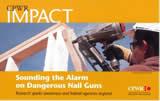Prevention of Injuries from Nail Guns in Residential Construction (Completed – 2004-2009)
Hester J. Lipscomb, Ph.D.
Duke University
Durham, NC
Ph:(919)286-3232 ext 256
[email protected]
Partners
James Nolan and Dennis Patterson, Local 2119 and 1310; Carpenters District Council of Greater St. Louis and Vicinity; Home Builders Association of Greater St. Louis.
Although nail gun injuries remain an under-recognized problem among residential carpenters, considerable progress has been made in reducing such injuries since Dr. Lipscomb began her research in 2000.
In surveys of carpenter apprentices, the lifetime prevalence of nail gun injuries was 22.6 percent in 2008, substantially lower than the rate of more than 44 percent in 2005. Injury rates per hours worked and per hours of actual tool use have both declined since 2005. In addition, a larger proportion of carpenters now seek medical care for nail gun injuries than at the beginning of the project.
With early training and increasing use of nail guns with sequential triggers, injury rates have declined over 50 per-cent. The sequential trigger by design avoids inadvertent discharge of nails which is the most common cause of injury. In 2006, over half of the hours apprentices spent nailing involved use of a sequential trigger for the first time.
What has not changed is the higher rate of injuries with the contact trip trigger gun, which has a two-fold higher injury rate than the sequential trigger gun even after considering training and experience. Inexperienced carpenters without training also continue to have a high injury rate. Nail gun injury rates still remain much higher than recognized, partly due to the fact that many injuries go unreported. For more on Dr. Lipscomb’s new efforts to reduce nail gun injuries through outreach and training, click here.
Original Project Abstract:
Nail guns are used extensively in residential construction. These tools increase worker productivity; but increased productivity has come at a price. Injuries from nail guns are one of the most common in residential construction; they can be serious and costly. Apprentice carpenters are at particularly high risk. The primary safety device to prevent unintentional discharges is the trigger mechanism. The more common contact trip design allows nails to be discharged from the tool anytime the nose and trigger mechanism are both depressed. Data indicate that the majority of injuries could be prevented if the tools had a sequential type trigger mechanism which requires the nose to be depressed before the trigger is pulled for the tool to fire. The International Staple Nail and Tool Association (ISANTA) sponsored an ANSI standard change in May 2003 that calls for shipping most framing guns with sequential triggers, but tools can still be fit with contact trip triggers. In addition, many tools remain in the workplace with contact trip triggers.
We propose a multi-level study focused on the evaluation of three very different efforts to prevent injuries from the use of these tools. Specifically, we plan to evaluate, and subsequently improve, current training efforts underway for apprentice carpenters in St. Louis , the only site in the U.S. with a large, unionized residential workforce. In collaboration with ISANTA, the Carpenters District Council and the Homebuilders Association we plan to evaluate current safety materials provided by the tool association. At a wider policy level we will evaluate the impact of the voluntary ANSI standard change over the five year time frame. Lastly, because we know this is a barrier to use of sequential trigger tools, we will compare productivity measures using contact trip and sequential trigger nail guns. The scope of our work builds on prior active surveillance and collaborations to address prevention of one of the most common acute injury hazards in residential construction. The joining of academic partners, the union, the homebuilders, and the trade association to address a serious safety problem in residential construction is unique.
